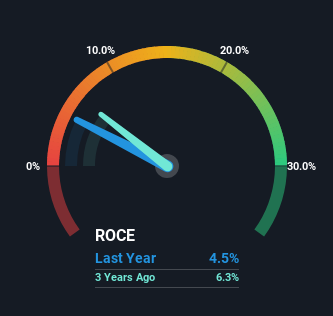- Hong Kong
- /
- Semiconductors
- /
- SEHK:1305
Here's What's Concerning About Wai Chi Holdings' (HKG:1305) Returns On Capital
There are a few key trends to look for if we want to identify the next multi-bagger. Amongst other things, we'll want to see two things; firstly, a growing return on capital employed (ROCE) and secondly, an expansion in the company's amount of capital employed. Put simply, these types of businesses are compounding machines, meaning they are continually reinvesting their earnings at ever-higher rates of return. However, after briefly looking over the numbers, we don't think Wai Chi Holdings (HKG:1305) has the makings of a multi-bagger going forward, but let's have a look at why that may be.
What Is Return On Capital Employed (ROCE)?
For those that aren't sure what ROCE is, it measures the amount of pre-tax profits a company can generate from the capital employed in its business. The formula for this calculation on Wai Chi Holdings is:
Return on Capital Employed = Earnings Before Interest and Tax (EBIT) ÷ (Total Assets - Current Liabilities)
0.045 = HK$38m ÷ (HK$2.5b - HK$1.6b) (Based on the trailing twelve months to June 2023).
So, Wai Chi Holdings has an ROCE of 4.5%. Ultimately, that's a low return and it under-performs the Semiconductor industry average of 12%.
Check out our latest analysis for Wai Chi Holdings

While the past is not representative of the future, it can be helpful to know how a company has performed historically, which is why we have this chart above. If you want to delve into the historical earnings, revenue and cash flow of Wai Chi Holdings, check out these free graphs here.
What Does the ROCE Trend For Wai Chi Holdings Tell Us?
In terms of Wai Chi Holdings' historical ROCE movements, the trend isn't fantastic. Around five years ago the returns on capital were 6.6%, but since then they've fallen to 4.5%. On the other hand, the company has been employing more capital without a corresponding improvement in sales in the last year, which could suggest these investments are longer term plays. It's worth keeping an eye on the company's earnings from here on to see if these investments do end up contributing to the bottom line.
On a side note, Wai Chi Holdings' current liabilities are still rather high at 66% of total assets. This effectively means that suppliers (or short-term creditors) are funding a large portion of the business, so just be aware that this can introduce some elements of risk. While it's not necessarily a bad thing, it can be beneficial if this ratio is lower.
Our Take On Wai Chi Holdings' ROCE
To conclude, we've found that Wai Chi Holdings is reinvesting in the business, but returns have been falling. Since the stock has declined 13% over the last five years, investors may not be too optimistic on this trend improving either. On the whole, we aren't too inspired by the underlying trends and we think there may be better chances of finding a multi-bagger elsewhere.
One final note, you should learn about the 2 warning signs we've spotted with Wai Chi Holdings (including 1 which makes us a bit uncomfortable) .
While Wai Chi Holdings isn't earning the highest return, check out this free list of companies that are earning high returns on equity with solid balance sheets.
Valuation is complex, but we're here to simplify it.
Discover if Wai Chi Holdings might be undervalued or overvalued with our detailed analysis, featuring fair value estimates, potential risks, dividends, insider trades, and its financial condition.
Access Free AnalysisHave feedback on this article? Concerned about the content? Get in touch with us directly. Alternatively, email editorial-team (at) simplywallst.com.
This article by Simply Wall St is general in nature. We provide commentary based on historical data and analyst forecasts only using an unbiased methodology and our articles are not intended to be financial advice. It does not constitute a recommendation to buy or sell any stock, and does not take account of your objectives, or your financial situation. We aim to bring you long-term focused analysis driven by fundamental data. Note that our analysis may not factor in the latest price-sensitive company announcements or qualitative material. Simply Wall St has no position in any stocks mentioned.
About SEHK:1305
Wai Chi Holdings
An investment holding company, manufactures and trades in light-emitting diode (LED) backlight and LED lighting products to business corporations and public utilities in the People’s Republic of China, Hong Kong, Taiwan, and internationally.
Excellent balance sheet with proven track record.
Market Insights
Community Narratives




